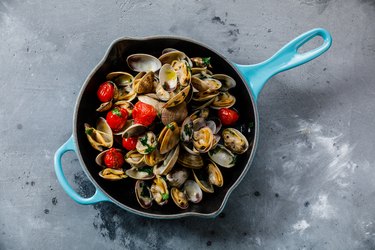
The benefits of clams are many. Whether steamed, fried or grilled, clams are a delicious and nutritious seafood, adding variety to your diet. Clams join sea snails, octopus, squid and scallops as popular ocean-sourced shellfish called mollusks.
Video of the Day
Video of the Day
Clams' nutrition properties are impressive. The USDA recommends eating a variety of seafood, including shellfish, twice a week at 8 ounces per week to obtain healthy omega-3 fatty acids that help prevent heart disease.
Plenty Vitamin B12 and Protein
One of the most notable benefits of clams is their extremely high vitamin B12 content. In a serving of 20 small clams (190 grams), there are 187.9 micrograms of vitamin B12, which is an astounding 7,829 percent of the daily value (DV).
According to the National Institutes of Health (NIH), vitamin B12 is important for maintaining healthy nerve and blood cells, as well as the prevention of megaloblastic anemia. The NIH recommends that people get most of their vitamin B12 from food. Clams and beef liver are the top food sources of vitamin B12.
Clams are high in protein, providing 48.5 grams in a typical 190-gram serving. One of the best benefits of clams is that their proteins provide several essential amino acids. These are amino acids that the human body cannot make, and therefore must be obtained from dietary sources.
Amino acids are the building blocks of life. The US National Library of Medicine lists growth, the breakdown of foods, repair of tissues and many other bodily functions as being the job of amino acids. A serving of clams provides over 100 percent of the recommended daily intake of 11 different amino acids, including all nine essential amino acids.
Clams Promote Heart Health
The polyunsaturated fatty acids in seafood, including shellfish, is one of the most beneficial reasons for consumption. Omega-3 fatty acids are considered essential in the diet because they must be obtained from food or supplementation. These fats help form the structure of cell membranes and aid in the health of the body's immune, cardiovascular, endocrine and pulmonary systems. Long-chain omega-3 fatty acids, called EPA and DHA, are only available through fish, fish oils and krill oils.
The USDA recommends 1.6 grams of omega-3 fatty acids per day for adult males and 1.1 grams per day for females. For pregnancy and lactation, 1.4 grams and 1.3 grams per day are recommended, respectively. Clams are a top source of omega-3 fatty acids, providing 50 percent of the daily adequate intake at 798 milligrams per 190-gram serving.
One serving of clams contains 0.4 grams of saturated fat. Saturated fat is known to raise low-density lipoprotein (LDL) cholesterol levels, the "bad" type of cholesterol. Too much LDL cholesterol raises the risk of heart disease. Conversely, unsaturated fats such as those found in fatty fish and shellfish help to prevent heart disease.
The other type of cholesterol, high-density lipoprotein (HDL), is beneficial. The Harvard School of Public Health explains that cholesterol is necessary for the creation of sex hormones, as well as vitamin D and other vital compounds.
HDL cholesterol is protective and is present in desirable levels in clams, at 127.3 milligrams in a 190-gram serving. The non-cholesterol sterols found in clams help to decrease the absorption of bad cholesterol, promoting health, according to the University of Illinois Department of Food Science and Human Nutrition.
What Are Clams’ Health Risks?
As long as clams are grown in clean water and harvested properly, they are very safe to eat, according to the Comprehensive Reviews in Food Science and Food Safety. When clams are not farmed and handled safely, hazards such as pathogens, biotoxins, parasites and pollutants can occur. Due to this, the production of shellfish is strictly monitored, so buying and consuming it from a reputable source is considered safe.
Be aware that some people are allergic to mollusks and other types of seafood. The Mayo Clinic reports that it is possible to only be allergic to one type of seafood, so watch for symptoms such as hives or a stuffy nose. Rarely, life-threatening allergies can occur. Talk to your doctor if you suspect an allergic reaction to clams so that tests may be performed.
As with any food preparation, be sure to thoroughly wash hands, cutting boards and utensils with hot soapy water before and after handling. As per instructions from the Office of Disease Prevention and Health Promotion, refrigerate clams until ready to use and cook until opaque. Be sure to freeze clams if they are not used within three or four days and cook immediately after thawing.
- My Food Data: "Nutrition Facts for Cooked Clams"
- United States Department of Agriculture: "10 Tips: Eat Seafood Twice a Week"
- National Institutes of Health: "Vitamin B12"
- National Institutes of Health: "Omega-3 Fatty Acids"
- U.S. National Library of Medicine:"Amino Acids"
- National Institutes of Health: "The Skinny on Fat"
- Harvard School of Public Health: "Cholesterol"
- University of Illinois Department of Food Science and Human Nutrition: "The Nutritional Value of Shellfish"
- Comprehensive Reviews in Food Science and Food Safety:"Shellfish: Nutritive Value, Health Benefits, and Consumer Safety"
- Office of Disease Prevention and Health Promotion:"Dietary Guidlines: Build a Healthy Base"
- Mayo Clinic: "Shellfish Allergy"